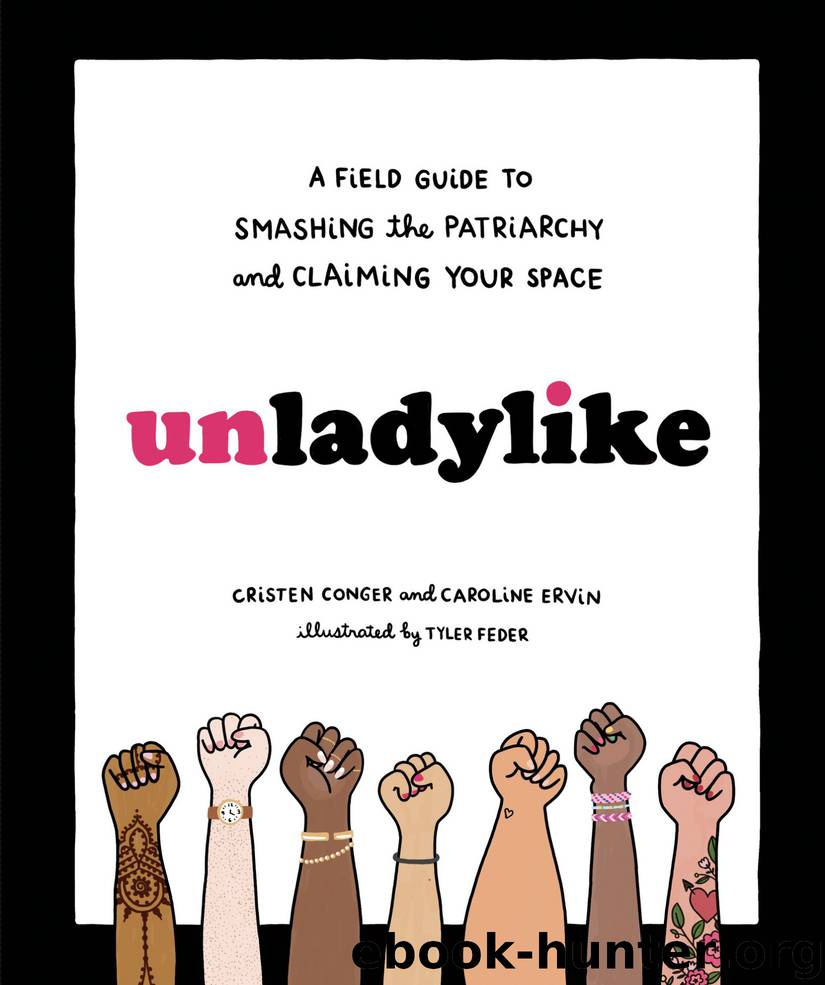Unladylike: A Field Guide to Smashing the Patriarchy and Claiming Your Space by Caroline Ervin

Author:Caroline Ervin
Language: eng
Format: epub
Tags: feminism, politics
Publisher: Ten Speed Press
Published: 2018-10-02T04:00:00+00:00
six degrees of dignity
Like #MeToo and #TimesUp, America’s first anti-rape reckoning started with women talking to one another and realizing they weren’t broken, crazy, or alone. Fed-up feminists knew better than to expect police, politicians, and the public to give a sh*t. Instead, unladylike sisters did it for themselves. In the 1970s, Women’s Lib consciousness-raising groups evolved into public protest and legal activism that yielded rape survival resources and a whole new language to describe the unspeakable—and patriarchy’s indifference to it.
Rape Crisis Centers
When Oleta Kirk Abrams’ fifteen-year-old foster daughter was raped, doctors treated her with such insensitivity that Oleta rallied two girlfriends and founded one of the first-ever rape crisis centers, Bay Area Women Against Rape, in 1971. The feminist grapevine caught wind, and within five years, four hundred other rape crisis centers had opened across the country, providing medical care, victim advocacy, therapy, self-defense classes, and models for survivor-centered responses to sexual assault and abuse.
Rape Crisis Hotlines
Social workers spearheaded the earliest hotlines, connecting advocates and survivors to community resources. Those phone numbers also reached women with the least access to feminist support networks, like Los Angeles’s first Spanish-language rape hotline founded by Chicana activists in 1976, and a multilingual hotline for non-English speaking Asian and Pacific Islander women established two years later.
Forensic Rape Kits
In the early 1970s, after discovering the absence of protocol for collecting forensic evidence of sexual abuse, Chicago assault survivor Marty Goddard invented the rape kit. Reliable scientific evidence would provide courtroom credibility to victims, but other philanthropies wouldn’t come near such a taboo issue. Scrappy Marty called in a favor to her galpal Christie Hefner, and the Playboy Foundation ended up underwriting the first standardized rape kits, which arrived in emergency rooms in 1978.
Sexual Assault Nurse Examiners (SANEs)
In the late 1970s and ’80s, nurses independently brought much-needed SANE-ity to emergency rooms where predominantly male doctors had little bedside regard for rape victims. Officially recognized in 1991, these feminist Florence Nightingales focus on physical and emotional trauma and recovery, specializing in harm prevention, STD and pregnancy risk evaluation and testing, and counseling.
Rape Shield Laws
Legal-eagle second-wave feminists championed the adoption of rape shield laws, which prevent victims’ sexual history from being used as character evidence against them in stranger rape cases. However, they typically include loopholes for when that sexual history includes the perpetrator.
Shades of Rape
Men didn’t criminalize husbands’ “marital privilege” until second-wavers led by activist Laura X (no last name to symbolize she’s no man’s property) called it for what it was and didn’t shut up about spousal rape until legislatures listened. In 1979, it was recognized as a crime for the first time. In the meantime, feminists began confronting victim-blaming of sexually active, single women who drink by identifying date rape and acquaintance rape for the first time in the late 1980s.
Download
This site does not store any files on its server. We only index and link to content provided by other sites. Please contact the content providers to delete copyright contents if any and email us, we'll remove relevant links or contents immediately.
| Anthropology | Archaeology |
| Philosophy | Politics & Government |
| Social Sciences | Sociology |
| Women's Studies |
On the Front Line with the Women Who Fight Back by Stacey Dooley(4795)
The Rules Do Not Apply by Ariel Levy(4787)
The Lonely City by Olivia Laing(4700)
Bluets by Maggie Nelson(4430)
The Confidence Code by Katty Kay(4157)
Three Women by Lisa Taddeo(3321)
Not a Diet Book by James Smith(3297)
Inferior by Angela Saini(3208)
Confessions of a Video Vixen by Karrine Steffans(3204)
A Woman Makes a Plan by Maye Musk(3174)
Pledged by Alexandra Robbins(3101)
Wild Words from Wild Women by Stephens Autumn(3039)
Nice Girls Don't Get the Corner Office by Lois P. Frankel(2969)
Brave by Rose McGowan(2763)
Women & Power by Mary Beard(2687)
Why I Am Not a Feminist by Jessa Crispin(2664)
The Girl in the Spider's Web: A Lisbeth Salander novel, continuing Stieg Larsson's Millennium Series by Lagercrantz David(2644)
The Clitoral Truth: The Secret World at Your Fingertips by Rebecca Chalker(2627)
Women on Top by Nancy Friday(2488)
